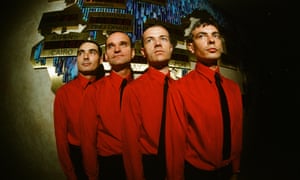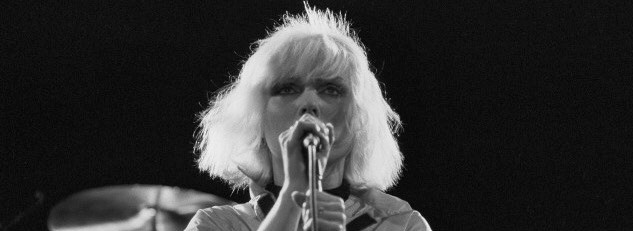
Debbie Harry and Chris Stein Live in Paradiso Amsterdam (1977), Photo Credit: Getty Images
Blondie was certainly intrigued by the disco culture at the time and how it took the music world by storm. Parallel Lines and “Heart of Glass” were both recorded towards the end of the disco peak. When first coming up with the original song for “Heart of Glass”, Debbie Harry and guitarist Chris Stein took inspiration from The Hue’s Corporation hit disco song “Rock the Boat” (Myers, 20). Additionally, Blondie’s guitarist recalls from their earlier gigs that much of their setlist included disco hits such as “Honey Bee” or “My Imagination” (Valentine, 73). There are a number of bands that Debbie Harry drew from; however, the most influential seems to be Kraftwerk. At the time of recording Parallel Lines, they were heavily listening to Kraftwerk and other bands that were not mainstream. Debbie Harry and Chris Stein credit many of these alternative bands for how their music was impacted, and what led them to create the music that would appear in their new album.

Kraftwerk in 1981, photo-shoot. Photograph: Shinko Music/Getty Images
Kraftwerk, a German band formed in 1970, is considered the innovator of electronic music. It popularized the techno genre with major albums such as Autobahn (1974), Trans-Europe Express (1977), and The Man-Machine (1978). The creation of their music revolved around the use of synthesizers, vocoders, and electronic drum machines. It created the electronic-pop genre by utilizing their instruments to develop songs with quick and random tempo changes (Bussy, 37). Due to their major fan base in Europe, Kraftwerk’s music quickly traveled to the U.K where Blondie drew influence from. It is no coincidence that Kraftwerk’s biggest albums were released only a couple of years before Blondie started to record Parallel Lines.
Blondie took a number of elements from Kraftwerk’s music. The rhythm and tempo for “Heart of Glass” is based around a rhythm machine and polyphonic synthesizer, which can be heard clearly at the start of the song. All of the other instruments are layered on top of the machines. The drummer, Clem Burke, played in a synthetic manner; meaning he had to be in time with the drum machine. This was not an easy task for a rock drummer who was accustomed to playing in a more wild, uncontrolled style. The guitarist, Chris Stein, had to play in a tempo so that every sixteenth note was in time with the rhythm machine (Porter 90). The precise timing of the instruments was crucial to creating the clean, electronic sound of new wave. Similar to Kraftwerk’s electronic pop, “Heart of Glass” has a number of meter shifts throughout the song, signaling a pop influence. The analysis of the meter shift is on the page titled “Heart of Glass.” Blondie incorporated their traditional rock backbeat and raw instruments with the electronic rhythm and tempo that Kraftwerk was known for. The synthesis of the genres showed how Blondie could artistically adapt to have mass appeal in a broader market than just in Europe.
